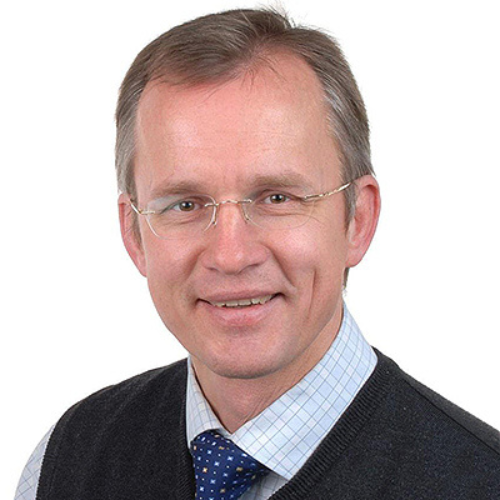“‘I hope and I am sure that the knowledge generated within the Immune-Image consortium will greatly advance our understanding of the in vivo dynamics of immune cells in various disease states.”
Andreas Jacobs from the University of Münster is leading work package 5 of the Immune-Image project together with Michael Schäfers of the Univerity of Münster and Ian Wilson of ImaginAb. In this work package they research the implementation of immunotracers for longitudinal assessment and therapy monitoring in pre-clinical disease models in vivo. We interviewed Andreas about his role in the project and the main goal of work package 5.

Can you briefly introduce yourself?
As a neurologist and geriatrician I am working in the field of molecular imaging for over 25 years. It started with “gene imaging” in gene therapy trials for glioblastoma multiforme (Jacobs et al. Neoplasia 1999; Jacobs et al. Cancer Res. 2001; Jacobs et al. Lancet 2001). At that time, I served as founding member of the Society for Molecular Imaging (now WMIS) and of the European Society for Molecular Imaging (ESMI). In addition, I served as Coordinator for the EU projects “Diagnostic Molecular Imaging” (DiMI; FP6) and “Imaging Neuroinflammation in Neurodegenerative Diseases” (INMiND; FP7). The current Immune-Image project originates, at least in part, from the latter project. From the scientific point of view, I would like to understand the role of microglial cells in various neurological diseases including brain aging and frailty and how the immune system can be therapeutically guided to eliminate tumor cells.
How did you get involved in the Immune-Image consortium?
Various partners of the Immune-Image project have been involved in the INMiND project which was funded between 2012-2018. From the various paradigms to image activated microglial cells by TSPO- and P2X7R-targeted agents the various ideas and working areas of the Immune-Image consortium have been, at least in part, being developed. As some partners of the Immune-Image consortium have been working together on the European level for almost 20 years, e.g., in the DiMI and INMiND projects, I personally believe that this trustful exchange of scientific ideas and collaboration is the major driving force to collectively elaborate answers to complex scientific questions, such as in the Immune-Image project.
What is your role and the role of the University of Münster?
As a former Coordinator of the INMiND project I feel highly responsible, together with the Immune-Image coordinator Bert Windhorst and the manager Sabine Stötzer, for the overall success of Immune-Image. Together with Michael Schäfers and Ian Wilson I take responsibility for the translational aspects of the project with regards to the lead of WP5, where newly developed radiotracers have to succeed in various evaluations in experimental model systems before they go into clinical application. The prerequisite to make WP5 successful is its high interrelationship with WP3 (tracer development) and WP4 (tracer validation) as well as with WP6 (clinical application). At the University of Münster, new S100A-based imaging agents are being developed as well as imaging paradigms for immune cell trafficking in humans. Moreover, immune cell imaging is being explored in experimental glioma models, which shall serve as paradigm for imaging immune therapy response in brain metastatic diseases.
What is the main goal of WP5?
The goal of WP5 is to validate and characterize existing and newly developed immune cell tracers by longitudinal assessment (repeated imaging) and therapeutic intervention as well as to provide proof-of-concept data in disease model systems for translation into clinical application in WP6. WP5 strongly interacts with WP3, 4, 6 to advance new molecular imaging paradigms from chemical development (WP3) through in vivo studies in animal models (WP4,5) into clinical application (WP6). WP5 has been designed to:
- localize and quantify the longitudinal dynamics of inflammatory cells in various biological systems (tumour, IMIDs) in vivo;
- establish an imaging platform for the evaluation of therapeutic immunomodulatory therapies;
- provide in vivo toxicity and safety profiles of selected candidate tracers for clinical transfer to WP6;
- provide methodology for quantification of immune cells in vivo for possible clinical application.
What do you hope Immune-Image will accomplish after 5 years?
The Immune-Image project is designed for the development of new imaging compounds enabling the in vivo localisation and quantification of specific immune cells in the dynamic disease process of tumors and inflammatory diseases. The work programme also includes the scientific challenge of engineering bispecific targeting compounds enabling the assessment of immune cell-cell interaction in vivo. I hope and I am sure that the knowledge generated within the Immune-Image consortium will greatly advance our understanding of the in vivo dynamics of immune cells in various disease states, including (i) immune evasion of tumors, (ii) successful immune therapy paradigms against tumors, and (iii) autoimmune diseases. The work within Immune-Image will greatly advance the field of imaging-based disease management of tumors and IMIDs.
What has WP5 achieved so far in the project?
The proposed imaging platform for the assessment of immune cell targeting compounds has been successfully established for describing the kinetics of the immune cell component of various disease states and for the assessment of therapeutic intervention with regards to the immune cell-based imaging read-out. Examples have been published, e.g. Barca et al. Cancers et al. 2022; Foray et al. JNM 2022; Barca et al. JNM 2022; Zinnhardt et al. NeuroOncol 2020. WP5 is currently preparing and awaiting the application of various newly developed radiotracers in the in vivo application.
Want to stay up to date about the Immune-Image project? Subscribe to our newsletter!
